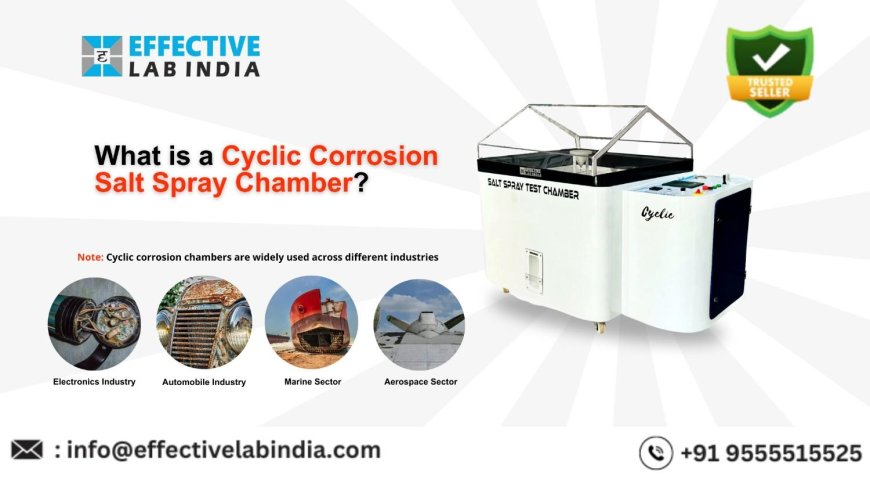Cyclic vs CASS Salt Spray Chamber: Key Differences Explained
CASS Salt Spray Chambers and Cyclic Salt Spray Chambers are the two most common types of chambers. While both are designed to evaluate the material’s resilience to harsh environmental conditions, their methodologies, applications, and simulated environments differ completely.

Salt spray chambers are important when testing the corrosion resistance of coatings and materials. CASS Salt Spray Chambers and Cyclic Salt Spray Chambers are the two most common types of chambers. While both are designed to evaluate the material's resilience to harsh environmental conditions, their methodologies, applications, and simulated environments differ completely. Requires an understanding of these differences to choose the best method for your unique and accurate testing needs.
To help you make an educated choice, we’ll break down the key differences between CASS and Cyclic Salt Spray Chamber in this article.
1. What is a Salt Spray Test?
Before we talk about the differences, let's take an instance to explain a salt spray test procedure. It is a standardized test to speed up the corrosion resistance of metal components and surface coatings. This test simulates a high-temperature condition in a controlled chamber, where salt water (sodium chloride solution) is atomized into a fine mist or fog. In this test, samples are exposed to a controlled, salty mist or fog inside a chamber to simulate harsh environmental conditions and accelerate corrosion. It is commonly used in industries such as automotive, aerospace, construction, paint & plating to check the durability and protective effects of paint, plating, galvanizing, and coating. It also helps manufacturers determine how long their manufactured products will be durable in daily use.

2. Cyclic Salt Spray Chamber: Overview
A Cyclic Salt Spray Chamber is designed to simulate varying environmental conditions by alternating between different climates, such as:
- Salt Fog
- Dry Condition
- Wetting Phases
- Humid Atmospheres
This chamber provides a more realistic and versatile image because it slowly places the objects under the cycles, accurately simulating real-world conditions. It is not only subjected to salt spray mist but also variable temperature, moisture content, and drying rate, making this a preferred durability testing method.

Key Features of Cyclic Salt Spray Testing:
- Simulates multiple environments in one cycle
- Replicates real-world conditions (rain, dry air, salt)
- Ideal for long-term corrosion and aging tests
- Common in automotive, aerospace, and marine industries
3. CASS Salt Spray Chamber: Overview
The CASS (Copper-Accelerated Acetic Acid Salt Spray) Salt Spray Chamber is a basic method for salt spray testing. The test is carried out with a mixture of acetic acid and copper chloride in a salt solution, which causes the water to evaporate rapidly to speed up the corrosion process. Originally designed to test chrome-plated parts, it is now widely used to test other coatings, such as anodized aluminum.
Compared to conventional salt spray testing, the CASS test chamber provides a complex environment to rapidly simulate degradation under high corrosion conditions. This is particularly useful in testing high-performance coatings and finishes.

Key Features of CASS Cum Salt Spray Testing:
- Accelerated corrosion process due to copper chloride
- Primarily used for coatings like anodized aluminum, chrome plating, and paint finishes
- Shorter testing cycles than standard salt spray chambers
- High intensity, ideal for testing corrosion resistance of industrial-grade materials
4. Key Differences Between Cyclic and CASS Salt Spray Chambers
Now that we understand how each chamber works, let’s dive into the key differences:
Feature
Cyclic Salt Spray Chamber
CASS Salt Spray Chamber
Test Environment
Varies between different climates
Constant, highly corrosive environment
Corrosion Acceleration
A slower, more natural process
Accelerated by copper chloride
Test Cycle Duration
Longer cycles simulate aging
Shorter cycles, rapid corrosion test
Ideal for
Real-world conditions, weather cycles
Harsh, extreme environments
Industries
Automotive, aerospace, marine
Coating manufacturers, metal finishing
Key Features
5. Which One Should You Choose?
The decision between Cyclic and CASS Cum Salt Spray Chambers depends largely on your specific testing goals and the material or coating you are evaluating.
- Choose a Cyclic Salt Spray Chamber if you need a comprehensive, real-world simulation that subjects materials to varying environmental conditions. It's great for industries like automotive and aerospace, where parts must withstand more than just corrosion but also changes in humidity and temperature.
- Choose a CASS Cum Salt Spray Chamber if you need a faster, more aggressive corrosion test, especially for coatings and materials that will be used in highly corrosive environments. It’s ideal for industrial-grade testing where time is a critical factor.
6. Conclusion
When evaluating materials and coatings for corrosion resistance, cyclic corrosion test chambers and CASS test chambers are both very useful instruments. While CASS offers quick and thorough testing, the cyclic corrosion salt spray chamber offers a comprehensive view of the environment. The decision will be based on the sectors you serve, the particular requirements of your product, and the types of material items that have been evaluated.
Making the best decision to guarantee your product lasts longer and longer in real usage will be made easier if you are aware of these important distinctions.
FAQs about Cyclic vs. CASS Cum Salt Spray Chambers
1. What is the main difference between Cyclic and CASS Cum Salt Spray Chambers?
Cyclic Salt Spray Chambers simulate various real-world environments, while CASS focuses on accelerated corrosion using copper chloride.
2. Which industries commonly use Cyclic Salt Spray Testing?
Industries like automotive, aerospace, and marine use Cyclic Salt Spray Testing for long-term durability and real-world environmental simulations.
3. Why is CASS Salt Spray Testing faster than Cyclic Testing?
CASS uses copper chloride to accelerate corrosion, allowing for quicker results in a shorter testing period compared to Cyclic Testing.
4. What types of materials benefit from CASS Salt Spray Testing?
Materials with protective coatings like chrome plating, anodized aluminum, and high-performance finishes are best suited for CASS testing.
5. Can Cyclic Salt Spray Testing be used for all materials?
Yes, Cyclic Salt Spray Testing is versatile and can be applied to various materials, but it's especially valuable for parts exposed to diverse environmental conditions.
What's Your Reaction?


























![Try Updated Atlassian ACP-100 Exam Dumps: Ideal For Best Preparation [2024]](https://news.bangboxonline.com/uploads/images/202410/image_430x256_66fe2218be93e.jpg)

